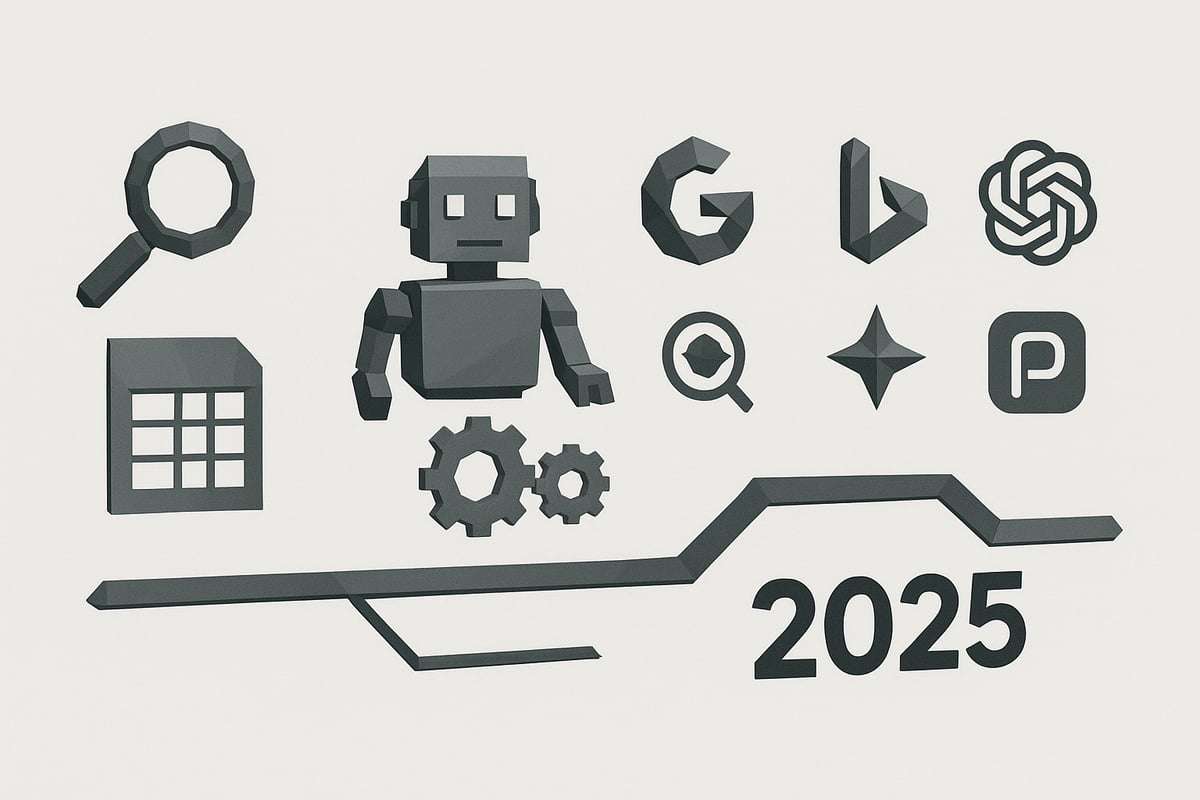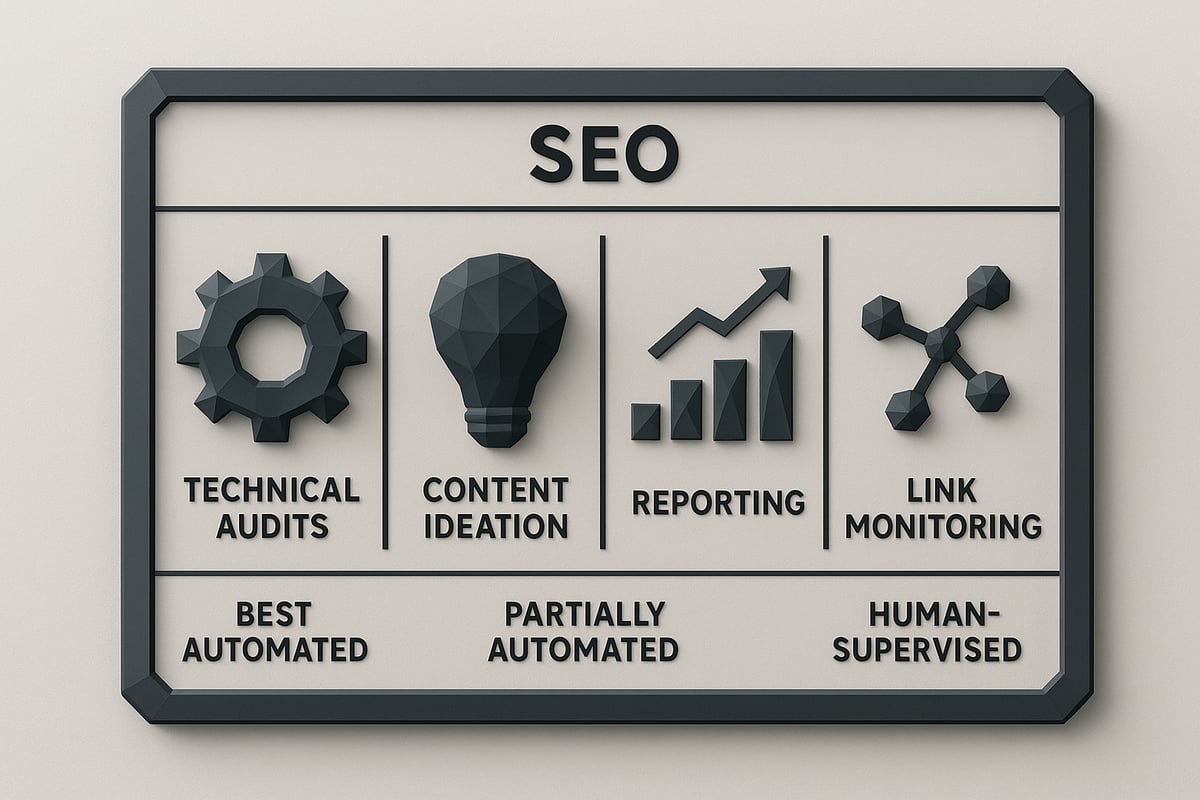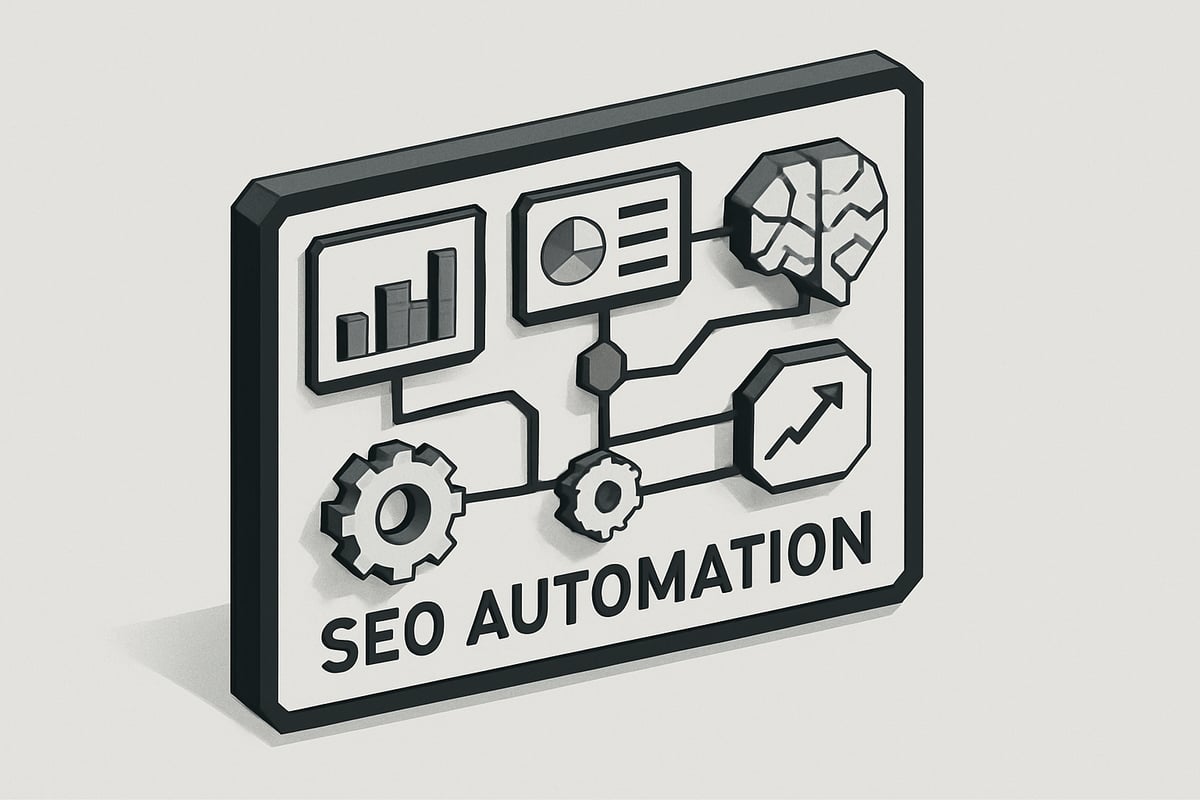Are you feeling overwhelmed by the never-ending cycle of SEO tasks? In 2025, digital marketing is being transformed by tools that automate seo, freeing up more time and delivering better results.
Imagine boosting your search rankings while your most tedious processes run silently in the background. With the right strategies, you can let advanced AI handle keyword research, content optimization, and even performance reporting.
This guide reveals how to master automate seo, from key automation tools to proven workflows. Read on to stay ahead of the curve and gain a true competitive edge in a rapidly evolving landscape.
The Evolution of SEO Automation: Why 2025 Is a Game-Changer
SEO has transformed dramatically over the last decade, shifting from painstaking manual processes to sophisticated AI-driven systems. In 2025, the need to automate seo is more urgent than ever. Early SEO relied on manual keyword research, laborious content audits, and repetitive reporting. Now, automation streamlines these tasks, freeing marketers to focus on strategy and creativity.

Technological innovation is the engine behind this change. Machine learning, natural language processing, and robust API integrations now allow professionals to automate seo at scale. AI tools can analyze massive datasets, identify trends, and execute optimizations in real time. These advances have made automation accessible not just to enterprises, but also to small businesses aiming for rapid growth.
The landscape is also being reshaped by search engine updates in 2025. Google has expanded its AI-powered search features, while Bing, ChatGPT, Gemini, and Perplexity are introducing new ways users discover content. As engines adopt more conversational and answer-based search models, the pressure to automate seo processes intensifies. Staying competitive means leveraging automation to adapt quickly to algorithm changes and emerging platforms.
Data shows this shift is mainstream. According to SEO automation statistics 2025, 70% of SEO professionals now use automation tools to manage core workflows. The rise of “search everywhere optimization”—including OmniSEO, GEO (Generative Engine Optimization), and AEO (Answer Engine Optimization)—demands an agile approach. Automation enables teams to optimize for multiple channels and devices simultaneously, reaching users wherever they search.
The drive to automate seo is also fueled by growing complexity and the need for real-time insights. Marketers face an explosion of data, evolving ranking factors, and fierce competition. Manual processes simply cannot scale. For example, businesses that automated their SEO operations have reduced manual hours by 50%, freeing teams to focus on high-impact projects and strategy.
Looking ahead, the future of automate seo is even more promising. Predictive analytics will anticipate search trends before they arise. Multi-language automation will support global campaigns with minimal manual input. AI-generated content will become smarter, providing high-quality, personalized experiences. These trends will define the next era of SEO, making automation not just a competitive edge but a necessity for success.
What Can (and Should) Be Automated in SEO?
Keeping pace with the demands of modern search means finding smart ways to automate seo. In 2025, automation is no longer a luxury but a necessity for scaling results, improving accuracy, and freeing up time for strategy.

Core SEO Tasks Ripe for Automation
Several foundational activities are ideal candidates when you automate seo:
- Keyword Research: AI-driven platforms can generate comprehensive keyword lists, analyze intent, and spot opportunities faster than any manual process.
- Content Ideation: Tools now surface trending topics, competitors’ top pages, and gaps in your content calendar.
- Technical Audits: Automated crawlers scan sites for errors, broken links, and site speed issues, delivering reports instantly.
- Reporting and Analytics: Live dashboards and scheduled reports ensure stakeholders always have updated data.
- Rank Tracking and Link Monitoring: Automation keeps your finger on the pulse of rankings and backlink health.
Automated reporting alone can save up to 10 hours each month per marketer. Industry data shows that nearly 70% of SEO professionals use at least one automation tool, with adoption rising annually. For more on which tasks are trending for automation, see these SEO tasks automation trends.
Tasks Best Left Partially Automated
Some areas benefit from automation but still require human input to maintain quality and relevance when you automate seo:
- Content Writing: AI can create drafts, outlines, or even full articles, but human editing ensures clarity, accuracy, and brand consistency.
- Meta Tag Optimization: Automated tools generate suggestions, yet manual review aligns with campaign objectives.
- Internal Linking: Plugins can insert links based on rules, but strategic placement and anchor text selection often need a human touch.
Tasks That Require Human Oversight
Despite advances in technology, certain elements should not be fully automated when you automate seo:
- Brand Voice and Messaging: Crafting a unique tone and narrative remains a creative, human-driven process.
- Strategic Planning: Deciding what to prioritize, target, or pivot cannot be left solely to algorithms.
- Sensitive Content Review: Automated systems may miss nuances or context in topics that demand careful handling.
Real-World Examples and Data
Consider how businesses use SEMrush or Ahrefs to automate seo keyword research, generating thousands of ideas in minutes. Reporting with Looker Studio lets teams create automated monthly updates, cutting manual reporting time by 40%. Automated link monitoring alerts marketers to lost or gained backlinks instantly.
Pros and Cons of SEO Automation
| Task | Pros | Cons |
|---|---|---|
| Keyword Research | Fast, data-rich, scalable | May miss niche or emerging topics |
| Content Ideation | Uncovers trends quickly | Lacks creative nuance |
| Technical Audits | Thorough, frequent checks | Overlooks context or business priorities |
| Reporting | Saves time, ensures accuracy | Generic insights without customization |
| Content Writing | Speeds up drafting process | Risks generic or off-brand content |
| Internal Linking | Improves structure, saves effort | Can create unnatural patterns |
Limitations and the Need for Balance
While the drive to automate seo brings speed and efficiency, full automation is not always advisable. Nuanced content, E-E-A-T (Experience, Expertise, Authoritativeness, Trustworthiness) requirements, and evolving search engine guidelines demand human judgment.
The most successful teams combine automation with strategic oversight. They use technology to handle repetitive tasks, while experts focus on creativity, intent, and long-term growth.
Step-by-Step: How to Automate Your SEO Workflow in 2025
Embracing the power to automate seo in 2025 is about more than saving time. It is about transforming your digital marketing workflow for better, faster, and more scalable results. With the right tools and strategies, you can streamline everything from keyword research to performance reporting in a few simple steps.
Below, we break down each phase of an automated seo workflow, providing actionable insights and real-world examples to help you build a future-proof process.

Step 1: Automated Keyword Research & Content Ideation
The first step to automate seo is transforming keyword research and content ideation using AI-powered tools. Platforms like FAQFox, WebFX, and n8n can generate comprehensive keyword lists and trending topic ideas within minutes. By integrating competitor analysis, you uncover new opportunities and target "low-hanging fruit" keywords that promise high ROI.
For instance, an automated n8n workflow can pull keyword gaps from competitors, cluster them by intent, and deliver prioritized lists straight to your content calendar. Businesses leveraging automated keyword research report content planning cycles that are 30 percent faster.
To dive deeper into practical methods and real-world examples, explore these Automated SEO strategies for step-by-step guidance.
Step 2: Streamlining On-Page Optimization
Next, automate seo by optimizing your on-page elements with AI. Tools like OpenRouter and DeepSeek can auto-generate meta titles and descriptions tailored to each page. WordPress plugins and custom scripts can update tags sitewide, saving hours of manual editing.
Many platforms now offer auto-internal linking and schema markup insertion. This ensures your content is not only optimized for search engines but also for user experience. A common workflow involves a plugin scanning new posts, updating internal links, and applying relevant schema automatically.
The impact is clear: automated on-page optimization leads to higher click-through rates and improved on-page SEO scores, all with minimal manual intervention.
Step 3: Automated Content Creation & Publishing
AI models have revolutionized how marketers automate seo content creation. With platforms like OpenAI and DeepSeek, you can generate high-quality drafts in seconds. Integrate these models with your CMS—such as WordPress or Webflow—to automate scheduling and publishing.
A practical example is an n8n workflow that pulls topic ideas from Google Sheets, drafts the content, optimizes it for keywords, and publishes it automatically. This pipeline increases content output by two to three times compared to manual processes.
Despite the automation, always include a human review step to ensure authenticity, accuracy, and alignment with your brand voice.
Step 4: Technical SEO Audits & Issue Monitoring
Technical health is critical when you automate seo processes. Schedule site crawls using tools like Screaming Frog or Sitebulb to scan for issues like broken links and crawl errors. With real-time alerts, your team can address problems before they impact rankings.
Automated audits can be exported and shared with stakeholders weekly. This not only speeds up issue resolution but also maintains high technical SEO health scores. Some platforms allow you to set up custom rules, so any deviation triggers an instant notification.
By automating technical audits, you reduce the risk of overlooked errors and ensure your site remains search engine friendly.
Step 5: Automated Reporting & Performance Tracking
The final piece to automate seo is streamlining reporting and tracking. Build live dashboards with Looker Studio, Google Analytics, and custom API integrations to monitor performance in real time. Automated rank tracking and backlink monitoring keep you updated without manual checks.
For example, marketers set up automated monthly reports that are delivered to stakeholders’ inboxes, summarizing keyword rankings, traffic changes, and technical health. These processes save up to 40 percent of reporting time.
With data-driven insights at your fingertips, you can make strategic decisions faster and focus more on growth.
Automating your seo workflow is not just about efficiency. It is about unlocking new levels of performance, agility, and competitive advantage. By following these steps, you position your business to thrive in the fast-paced digital landscape of 2025.
Top SEO Automation Tools & Platforms for 2025
Staying ahead in 2025 requires the right technology stack to automate seo efficiently. The landscape is more competitive than ever, and the right tools can make or break your strategy. Let’s explore the leading platforms, AI-powered content generators, and automation solutions that are shaping the future of seo automation.

Comprehensive Overview of Leading Platforms
To automate seo at scale, marketers rely on robust platforms. SEMrush and Ahrefs stand out for all-in-one solutions, offering keyword research, rank tracking, and technical audits. Moz continues to be a favorite for its user-friendly interface and actionable insights.
Screaming Frog and Sitebulb excel in technical site audits, providing detailed crawl analysis. Looker Studio transforms data into visual dashboards, centralizing performance metrics. For those seeking workflow automation, n8n and Zapier integrate multiple seo tools for streamlined operations.
For a deep dive into the capabilities and comparisons of these platforms, see this SEO automation software guide.
AI-Powered Content Generators
AI-driven content creation is transforming how teams automate seo workflows. OpenAI and DeepSeek offer advanced language models for drafting high-quality, seo-optimized content. Jasper specializes in generating blog posts, meta descriptions, and ad copy, adapting to various tones and topics.
These tools accelerate content ideation and production, freeing up time for strategy. Marketers can quickly generate outlines, FAQs, and even optimize existing pages. However, human oversight remains essential to ensure accuracy and maintain brand voice when you automate seo content creation.
Workflow Automation Platforms
Efficient management of complex processes is key to automate seo in 2025. Platforms like n8n, Zapier, and Make allow users to connect disparate tools, automating tasks such as data imports, publishing, and reporting.
Prebuilt integrations with WordPress, Google Sheets, and analytics tools enable seamless automation. For example, marketers use n8n to trigger content updates or send performance alerts based on real-time data. This orchestration not only saves time but also reduces manual errors in automate seo campaigns.
Specialized Tools, New Entrants, and Comparison Table
Specialized tools tackle specific challenges in seo automation. For technical audits, Sitebulb and Screaming Frog are top choices. Looker Studio excels at automated reporting, while OmniSEO and AI-powered internal linking tools are gaining traction for advanced optimization.
Emerging solutions now support image, video, and multi-language content generation. Here is a comparison of leading platforms:
| Tool | Best For | Key Feature | Pricing |
|---|---|---|---|
| SEMrush | All-in-one SEO | Keyword research | $ |
| Ahrefs | Backlink/Content analysis | Site explorer | $ |
| Moz | User-friendly SEO | Page optimization | $$ |
| Screaming Frog | Technical audits | Deep site crawl | Free/$ |
| Looker Studio | Reporting | Data visualization | Free |
| n8n | Workflow automation | Custom integrations | Free/$ |
Choosing the right mix of tools depends on your goals for automate seo, whether it’s scaling content, technical health, or data-driven reporting.
User Feedback, Selection Criteria, and Conclusion
User experiences highlight the impact of automation. As one marketer shared, “Automation with n8n reduced our publishing time by 60%.” Teams appreciate platforms that integrate easily with existing workflows and provide reliable support.
When selecting tools to automate seo, consider:
- Scalability for growing sites
- Integration with CMS and analytics
- Ease of use and documentation
- Responsive customer support
In 2025, the right automation platform empowers marketers to focus on strategy, not repetitive tasks. By adopting the right mix of tools, you can automate seo processes for better results and a sustainable competitive advantage.
Building a Custom SEO Automation Workflow: Practical Templates & Examples
Creating a custom workflow to automate seo tasks is the key to scaling your digital marketing efforts. With the right approach, you can reduce manual work, minimize errors, and unlock new levels of efficiency.
Step-by-Step: Designing Your SEO Automation Workflow
To automate seo in 2025, start by mapping out your recurring SEO tasks. Identify which processes can be automated, such as keyword research, content generation, on-page optimization, and reporting.
A typical workflow includes these stages:
- Input Collection: Gather keywords, topics, and URLs, often using a Google Sheet as your data source.
- Keyword Research Automation: Use AI-powered tools to find search opportunities. For a detailed walkthrough, see this Automate keyword research process.
- Content Generation: Integrate AI models for drafting, title creation, meta tags, and image suggestions.
- Optimization: Apply automated internal linking, schema markup, and keyword density checks.
- Publishing: Connect your workflow to a CMS like WordPress or Webflow for scheduled publishing.
- Reporting: Automate performance tracking and updates back to your Google Sheet.
By designing these workflows, you ensure that your automate seo efforts are both scalable and adaptable.
Example: Automating Blog Post Creation with n8n and Google Sheets
Let’s look at a practical example of how to automate seo blog post creation from ideation to publication.
Workflow Outline:
- Data Source: Store blog topics, keywords, and briefs in Google Sheets.
- Trigger: n8n monitors the sheet for new entries.
- Content Generation: AI model creates draft content based on the topic and keyword.
- SEO Optimization: The workflow adds meta titles, descriptions, and auto-generates internal links.
- Image Integration: AI suggests or generates relevant images.
- Publishing: Content is pushed to WordPress or Webflow, scheduled automatically.
- Performance Feedback: n8n updates the sheet with live URLs and performance metrics.
Here’s a simple code block for automating content updates from Google Sheets:
# Example: n8n workflow node for Google Sheets update
def update_google_sheet(row_id, url, performance):
# Connect to Google Sheets API
# Update row with URL and performance data
pass
This end-to-end approach lets teams automate seo content pipelines, resulting in faster, more consistent publishing.
Customization Tips and Best Practices
To maximize your automate seo workflow, consider these customization options:
- Add keyword density checks to ensure content stays optimized.
- Build internal linking logic that references existing posts by topic relevance.
- Integrate social sharing triggers for newly published content.
- Schedule regular automated technical audits to catch issues early.
Best Practices:
- Test each workflow component before full deployment.
- Monitor error logs and set up alerts for failed tasks.
- Regularly update your AI models and tool integrations for better results.
- Document workflows for easy onboarding and troubleshooting.
Teams using automated workflows report up to 50% fewer manual errors, making automate seo a critical strategy for sustainable growth.
Future-Proofing Your SEO Automation Strategy
Staying ahead in SEO means more than simply adopting new tools. To truly future-proof your approach, you must adapt to rapidly changing search engines, evolving user behaviors, and stricter compliance requirements. Here is how to strategically automate seo for the future.
Adapting to AI-Driven Search Engines
Search engines are no longer just about blue links. In 2025, AI-driven engines like Google SGE, Bing Copilot, and answer engines such as Gemini and Perplexity are redefining search. These platforms interpret intent, context, and user preferences with unprecedented accuracy.
To automate seo effectively, you must ensure your workflows can adapt to structured data, conversational queries, and answer-focused results. Embracing OmniSEO, GEO, and AEO will help your content surface in these intelligent environments.
Embracing New Search Behaviors and Technologies
Voice search, multimodal AI, and “search everywhere” optimization are now mainstream. Users expect instant answers, visual content, and seamless cross-device experiences. As you automate seo, prioritize multi-language capabilities and support for diverse content formats.
Predictive analytics and user intent modeling will be critical for anticipating trends. Investing in automation that supports these technologies ensures your strategy remains relevant as search habits evolve.
Balancing Automation with Oversight and Compliance
While automation accelerates SEO, ongoing human oversight is essential. Quality control, brand voice, and ethical standards cannot be fully automated. Regular audits, manual reviews, and compliance with evolving search engine guidelines safeguard your reputation.
As public awareness of SEO practices grows, transparency and responsible automation become vital. For a deeper understanding of how users perceive automation in search, review this research on public awareness of SEO.
Action Plan: Future-Proof Your SEO Automation
High-growth businesses are doubling down on automation: 80% plan to expand their efforts in the coming year. Use this checklist to future-proof your stack as you automate seo:
- Audit current automation workflows for gaps and redundancies
- Upgrade to AI-powered tools with predictive and multi-language capabilities
- Secure integrations across platforms (WordPress, Webflow, Shopify)
- Establish ongoing manual review and quality control processes
- Monitor compliance with search engine and data regulations
For a comprehensive overview of the latest AI tools to automate seo, explore the Best AI SEO tools 2025 and keep your strategy at the cutting edge.
As you’ve seen throughout this guide, mastering SEO automation in 2025 isn’t just about saving time—it’s about working smarter and staying ahead in a fast-changing landscape. If you’re ready to move beyond manual tasks and build a workflow that actually drives results, there’s never been a better moment to start. With platforms like RankPill, you can automate everything from keyword research and competitor analysis to content creation and publishing, all while maintaining quality and gaining a real competitive edge. Let’s take the next step together—Get Started and see how effortless SEO automation can be.